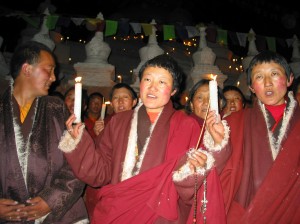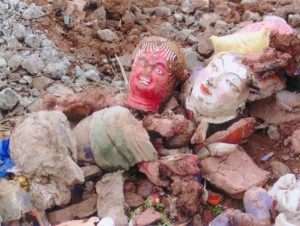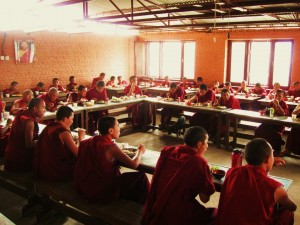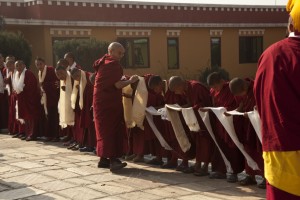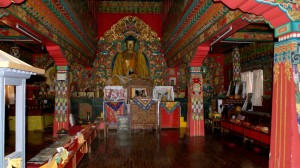March 2010
 From the foothills of the Himalayas, I send my best wishes to you for a happy and prosperous 2010.
From the foothills of the Himalayas, I send my best wishes to you for a happy and prosperous 2010.
As usual, I’ve been quite busy–partly with projects I have initiated and partly with fulfilling the vision and obligations set in motion by the First and Second Tsoknyi Rinpoches. It is my intention in this letter to discuss the projects in which I’ve been engaged primarily in Tibet and Nepal. I intend in the near future to share my thoughts about developments in the Americas and Europe.
To put projects in Tibet and Nepal into some historical context, I would like to remind you that over the past 1,000 years, the great masters in Tibet worked ceaselessly to preserve and promote the teachings of the Dharma, bringing the opportunity of enlightenment to generations of dedicated practitioners. The First Tsoknyi Rinpoche, while building and maintaining several monasteries in Eastern Tibet, placed special emphasis on ensuring that female practitioners were accorded the same opportunities as their male counterparts, rebuilding nunneries and retreat communities that had fallen into disrepair and establishing new ones. The Second Tsoknyi Rinpoche continued his efforts in that direction quite successfully until the Cultural Revolution swept through Tibet and all but obliterated the great centers of learning and training. Thousands died during that dark time, including the Second Tsoknyi Rinpoche, who was caught as he attempted to flee across the border to India. Those who escaped the purge went underground, practicing in secrecy and silence, in great fear for their lives, but unwavering dedication to the Dharma.
Fortunately, a great many masters–such as his Holiness The Dalai Lama, His Holiness The Karmapa, Khamtrul Rinpoche, and my own father, Tulku Urgyen Rinpoche–had managed to leave the country prior to the catastrophe. Together with many of their followers and members of the Tibetan community, they built new monasteries and practice centers in host countries like India and Nepal, and these institutions grew and flourished.
But for nearly 20 years, there was only silence in Tibet.
In the 1980s, however, the restrictions on practice put in place after the Cultural Revolution began to lift, and the teachers, monks, and nuns who had spent two decades in hiding began to emerge. Slowly, they began to rebuild monasteries and retreat communities, where they could practice openly and bring the Dharma to a new generation of Tibetans, hungry for spiritual guidance and nourishment. Gradually, monks and nuns were allowed to travel to India and Nepal for training at the centers established there, and in time many of the masters who had spent years in exile were permitted to return to Tibet and reestablish contact with those who had kept the words and teachings of the Buddha alive, and assist in the efforts of teaching and rebuilding.
However, during that 20-year interval, the monasteries built in the “borrowed lands” of India and Nepal had grown into established institutions, shining the light of the Dharma not only among the communities of exiles, but across the modern world. The masters who had founded these institutions, and the monks and nuns who had trained there, could not simply abandon them. Consequently, many teachers and lineage holders, including myself, find ourselves straddling two worlds, two commitments: continuing to expand our efforts in Nepal and India, and helping to reestablish and rekindle the Dharma in Tibet.
My mission, as someone trained in the centuries-old tradition of Tibetan Buddhism and teaching in the 21st century, is to preserve, protect, promote, and provide access to the ancient wisdom of the East, while at the same time forming a bridge between Tibetan Buddhist teachings and the modern wisdom of the West.
I’d like to take some time to share with you a bit about the progress that has been made in recent projects I’ve been working on, both in Nepal and in Tibet.
In Nangchen, Eastern Tibet, I supervise 26 monastic institutions and retreat centers that were established by the previous incarnations of Tsoknyi Rinpoche. Some of these monasteries and centers were established for monks, but a larger number were established for the benefit of women who felt an overwhelming longing to commit to monastic life.
Some of you may be confused by the term “monastic.” On the surface, it would seem that this term refers to monks; but the deeper meaning of the word points to those who have made a vow to free those bound by the chains of ignorance of their essential nature, which is love and compassion toward all living beings. Some monastics have taken quite a number of vows, but the essence of all of them is the vow to serve, to help as many sentient beings as possible to realize that their happiness, their very survival, depends upon dedicating their lives to the welfare of all sentient beings–even those who hate and abuse them. So the term “monastic” refers equally to monks and nuns.
It is an honor and a privilege to carry on the commitments made by prior Tsoknyi Rinpoches. But I must say that I would not have been able to carry out my duties without the extraordinary courage of those who had been trained by my predecessors. They kept the tradition of teachings and practices alive in the face of overwhelming forces and the punishments of slavery, rape, and murder. Those of you who have seen the documentary film Blessings will see evidence of the harsh measures carried out against those caught up in the Cultural Revolution, the bravery of those who managed to maintain their commitments and keep the training alive in the face of seemingly impossible odds, and the relief of those of a new generation who are now able to receive the treasury of wisdom held by survivors. After a recent survey conducted by Pundarika U.S., there are approximately 2,000 monastics living in the newly rebuilt monasteries and retreat centers.
Although the residents of nunneries and other institutions have, in recent years, been granted permission to rebuild, the members of these 26 communities face formidable obstacles. Many of them go without meals for days at a time because land use regulations deprive them of the right to grow their own food. Water is in short supply; it must be carried in buckets from springs and streams that aren’t nearby. As a result, the women and men who are struggling to reestablish the Dharma in Tibet go without water to cook, make tea, or even accomplish something as simple as to wash their hands. The small shelters they have built of mud and stone–often occupied by 15 people at a time–quickly deteriorate due to harsh climatic conditions, and they can’t afford even the basic accommodations of windows or doors. Three-fourths of the 2,000 nuns and monks living in these shelters go without heat during winters that drop to temperatures so far below freezing that most of us cannot even imagine. Access to even the simplest forms of medical care–including treatment of heart problems, liver, kidney, and gall bladder failures, arthritis, and eye failure–cannot be treated, because the cost of transferring ill residents to medical centers in dense, urban areas is too much. So, with each year, illness, death, and blindness cost us a bit more loss of the light of Dharma.
Yet despite the difficulties the nuns and monks in Nangchen endure, they have not lost sight of their commitments or their duties. Every day they wake before dawn to begin practicing together on behalf of all sentient beings. No matter their cold or hunger, they gather together four times a day for communal practice. At night, many of them practice dream yoga, to benefit beings through their prayers even while they sleep.
Many of the nuns are accomplished masters of tummo, the yoga of inner heat. They perform yearly rituals for the public that include a long procession around the monastery in the dead of winter in sub-zero temperatures, with only a sheet wrapped around their bodies. During the night, hundreds of the most adept nuns dip their sheets repeatedly in buckets of melted snow and continue their procession, drying the sheets again and again with the inner heat from their bodies, generated by their yogic practice. This very rare and awe-inspiring event, as well as the realization of the elder nuns, has gained them respect and renown throughout Tibet. In a culture where female practitioners have struggled to gain respect, these nuns have risen to a high level of status, with many monks and lamas seeking their teachings and instruction.
These dedicated nuns also serve surrounding communities through spiritual support and counseling, helping with blessing ceremonies for the living and prayers for the dead. Despite their own hardships, their commitment to serve the needs of those around them offers tangible evidence of the example of the power of spiritual influence. The communities that surround the nunneries have, in recent years, become markedly more peaceful. Violence, alcoholism, and other harmful habits have declined. The harsh speech that dominates so many disputes has dropped off considerably.
 Tsechu Gonpa
Tsechu Gonpa
I have to share with you some sad news regarding Tsechu Gonpa, the monastery in Nangchen founded by my esteemed teacher, Adeu Rinpoche, who passed the Drukpa Kagyu lineage on to me. As many of you know, the Drukpa Kagyu lineage, which holds the teachings and practices of Milarepa’s “secret student,” Rechungpa, is in danger of extinction. Preservation of this sacred lineage of teachings and practices is extremely important. Many core teachings and practices could be lost to the winds of time without effort.
As some of you may know, an earthquake in Nangchen devastated Tsechu Gonpa in November 2009. Of the 150 monks who survived, only 50 can gather now in a smaller shrine hall for prayers and group practice. The main assembly hall–once capable of accommodating nearly 700 people, who gathered there to receive empowerments and teachings–was mostly destroyed.
Rebuilding Tsechu Gompa must begin soon, before the temperatures begin to warm. The monastery is full of precious statues and relics acquired by Adeu Rinpoche after the end of the Cultural Revolution. These relics and statues are as important as the oral and written teachings of past and present masters. Removing the relics to a safe place is the first stage of the massive project of rebuilding.

In Nepal, I’ve been engaged in overseeing Ösel Ling monastery in Kathmandu, as well as two nunneries, Chumig Gyatsa and Gebchak.
Ösel Ling has grown tremendously over the past few years. Our initially small community of 30 monks has now expanded to include approximately 120 monks in various stages of training. Accommodating this larger community–as well as the increased number of visitors who have come to study and practice at the International Buddhist Meditation Center at the monastery–has required some physical changes.
I’m very pleased to announce that early 2009 saw the completion of an addition to both the monks’ quarters and the visitors’ wing. Lama Tashi had important oversight responsibilities for this 15-year project, which served as only one small aspect of his many Dharma-related duties in both the east and west.
Ramon and Elena Alvarez have administered Ösel Ling. With sincere dedication and compassion, Ramon and Elena ensure that residents and visitors are well fed, that there is an adequate supply of water and other supplies, and that the rooms, buildings, and grounds are kept in good repair. They have also used considerable skill in cultivating awareness among the monastic community of the need for sensitivity to the environment and the importance of maintaining health and hygiene. I cannot thank them enough for their efforts.
I’d also like to take a moment to acknowledge some members of the monastic community for their achievements and contributions. Recently, two of our monks, Karma Thaye and Mipham Namgyal, completed a three-year training program in torma making, under the guidance of His Holiness the 17th Karmapa. Karma Thaye was awarded special recognition for his skill and talent. Rigdzin Tarchin, meanwhile, has been training under a master in nearby Boudhanath in the fine art of thangka painting and has been busily engaged in the fine decorative work involved in repainting the exterior of the main shrine hall. Ngawang Chöjong has also been traveling back and forth between Ösel Ling and Boudhanath to study Tibetan medicine. In addition, Yeshe Tarchin has, over the past few years, become an expert tailor, sewing robes for the ever-growing monastic community as well as creating beautiful hangings and other ritual ornaments for the main shrine hall. My hope is that the talents these young men bring to the monastery will not only help to carry on important traditions and pass their training along to other residents, but will also use their skills to serve members of the surrounding community.
 More changes came to Ösel Ling in February, when my brother, Mingyur Rinpoche, assumed primary responsibility for the monastery. He will be bringing with him quite a number of monks from Tergar Monastery in India, who will join with the monks here at Ösel Ling in the creation of a shedra, or monastic college, which will provide opportunities for studying more advanced levels of Buddhist philosophy and practice.
More changes came to Ösel Ling in February, when my brother, Mingyur Rinpoche, assumed primary responsibility for the monastery. He will be bringing with him quite a number of monks from Tergar Monastery in India, who will join with the monks here at Ösel Ling in the creation of a shedra, or monastic college, which will provide opportunities for studying more advanced levels of Buddhist philosophy and practice.
Meanwhile, conditions for the 55 nuns at Chumig Gyatsa in Muktinath are continuing to improve. With the residential quarters and medical clinic complete, we turned our attention three years ago to building a shrine hall, where the nuns can study and practice together. Construction of the exterior–built entirely of natural materials–was finished in 2009, and this year we’re focused on completing the interior, with high hopes of opening the shrine hall at the beginning of 2011. As the work proceeds, the nuns continue their regimen of spending half the year in retreat and half the year in bringing spiritual aid and comfort to the residents of villages in the mountainous Mustang region.
I have news as well about Gebchak Nunnery. Because conditions in Pharping had recently grown unsettled, we relocated the nunnery to a small, existing building in Chobar, which is much closer to Kathmandu and temporarily safer for the nuns.
The land in Pharping will be held in trust for future development. Last year, we completed a road from the main highway to the nunnery and purchased additional land in order to expand the facilities to include 30 residential quarters, a kitchen and dining hall, a library, and a classroom building.
These new facilities in Pharping will serve for the envisioned Womens’ Teachers Project, which includes a thorough education of qualified nuns to become teachers and holders of the Tsoknyi Lineage. It is foreseen that these nuns not only will teach in Tibetan, but in English as well, which is particularly important for the West. In the same spirit as explained to you before, these accomplished woman masters will, to a vast extent, fulfill the vision for female practitioners that both the previous Tsoknyi Rinpoches had.
We also plan to build a guesthouse for visitors, which will eventually serve as the new home for the International Buddhist Meditation Center, a place of refuge and study where nuns and visitors can inspire and assist one another in achieving spiritual goals.
In addition, the Gebchak nuns have just completed a six-month retreat focused on tummo (inner heat) practice, one of the six yogas of Naropa. At the end of January, they successfully completed a test of their mastery of this essential practice of the Tibetan Buddhist tradition.
* * * * * *
Of course, none of these achievements would have been possible without your kind and generous support. Food, water, medical care, construction materials, and the resources necessary for maintaining and expanding the living, teaching, and practice facilities are needed in order for these dedicated men and women to continue their work of preserving, protecting, and promoting the Dharma and providing spiritual and other forms of service to their communities.
We realize that many of you may be experiencing financial hardship right now, but whatever contribution you are able to offer at this time will help the nuns and monks in Tibet and Nepal immensely. All donations are, of course, tax-deductible.
Through your assistance, you also participate in the great work of shining the light of the Dharma across the world and will receive great blessings. As Milarepa often said, whoever helps the yogi practicing in the mountains achieves the same merit as the yogi.
Along with your contributions, I also urge you to submit requests for prayers on behalf your friends, family members, and yourselves. The prayers of those who have dedicated their lives to serving all sentient beings are quite effective. So don’t be shy about submitting prayer requests! The Chobar nuns will include your prayer requests in their daily practice. Please go to www.pundarika.org to do this.
In that spirit, I humbly request you to continue your support and rejoice in the work we share together.
With deep love and respect,
Tsoknyi Rinpoche




